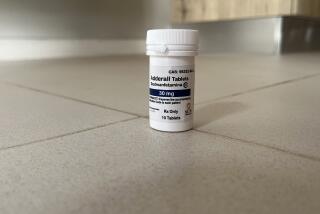Shortage of Snake Antivenin Has Hospitals Rattled
- Share via
TUCSON — After federal inspectors last winter found “quality control” problems at the only pharmaceutical plant in the country that makes rattlesnake antivenin, production was halted until 2001. Now, at the height of snakebite season, the Pennsylvania manufacturer is rationing its limited inventory, leaving some hospitals fretting about their meager supplies.
Nowhere has the antivenin shortage caused more jitters than here in the Sonoran Desert, the rattlesnake capital of North America.
It’s not that snakebite victims are dying for lack of antitoxin. Although Arizona hospitals have only half as many of the 10-milliliter vials on hand as they anticipate needing in August and September, when the rattler population is at its peak, the manufacturer says it has a sufficient (but undisclosed) quantity in stock. The company says it’s prepared to quickly supply any emergency room in the country that runs critically short of the lifesaving serum while treating a patient.
Still, poison control specialists here are uneasy. Because the amount of serum needed to treat a bite can’t be predicted--some victims need none, others 50 vials or more--the Arizona Poison and Drug Information Center in Tucson is keeping close track of antivenin supplies statewide. It wants to be able to coordinate borrowing among hospitals if a crisis arises and the company can’t deliver.
Officials also are urging campers, gardeners, golfers, joggers and other Arizonans to be extra careful where they step this summer.
“How nervous we are is really dependent on how much information we get from the company about how much [antivenin] they have available,” said toxicologist Jude McNally, the poison center’s manager. “And the problem is, they’re not telling us how much they have, except to assure us they have enough.”
In other parts of the country (notably the Southeast, where rattlers slither in the forests and swamplands), some of McNally’s colleagues are equally apprehensive, said an official of the American Assn. of Poison Control Centers.
The “controlled inventory situation,” which Wyeth-Ayerst Laboratories says is necessary to prevent hoarding, won’t raise eyebrows in Maine, say, or in Washington, D.C. Most Americans will never glimpse a rattler out of captivity, let alone feel the clamp of its jaws. Deaths from venom are rare even in the herpetologic wonderland of Arizona, where about a dozen people have been killed by rattlesnakes in McNally’s two decades at the poison center.
But with 11 types of rattlers thriving here--the biggest variety in the country, including the super-poisonous Mojave--Arizona hospitals treat hundreds of bites a year, most of them very painful and some nearly fatal. With more and more subdivisions pushing deeper into the desert beyond this city of 450,000, regional firefighters answer nearly 6,000 calls a year from residents who come upon rattlesnakes in garages and closets, on porches and driveways, in gardens, trash cans and public parks.
No one knows how many people nationwide are treated for rattlesnake bites every year. McNally’s state-funded poison center, which gives treatment advice to all Arizona hospitals outside the Phoenix area, consults in 200-plus cases annually, most of them from July to early fall, the period when newborn rattlers swell the snake population. If history holds, he said, Arizona emergency rooms will need at least 2,000 vials through the rest of this season. He said a recent survey found only half that many on hospital shelves.
With antivenin production halted until early next year, the manufacturer said it wants to prevent worried hospitals from overstocking and preserve its limited inventory for emergencies.
“We feel quite comfortable . . . that we have enough on hand to get us through this situation,” said Doug Petkus, a Wyeth-Ayerst spokesman. If a hospital desperately needs antivenin, he said, “we feel we can get it there within a matter of hours.”
More to Read
Sign up for Essential California
The most important California stories and recommendations in your inbox every morning.
You may occasionally receive promotional content from the Los Angeles Times.













